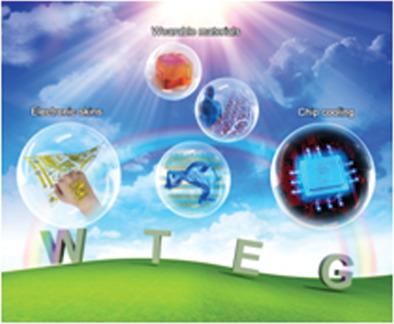当前位置:
X-MOL 学术
›
Adv. Mater.
›
论文详情
Our official English website, www.x-mol.net, welcomes your feedback! (Note: you will need to create a separate account there.)
Wearable Thermoelectric Materials and Devices for Self-Powered Electronic Systems
Advanced Materials ( IF 29.4 ) Pub Date : 2021-09-05 , DOI: 10.1002/adma.202102990 Yanhua Jia 1 , Qinglin Jiang 1 , Hengda Sun 2 , Peipei Liu 1 , Dehua Hu 1 , Yanzhong Pei 3 , Weishu Liu 4 , Xavier Crispin 5 , Simone Fabiano 5 , Yuguang Ma 1 , Yong Cao 1
Advanced Materials ( IF 29.4 ) Pub Date : 2021-09-05 , DOI: 10.1002/adma.202102990 Yanhua Jia 1 , Qinglin Jiang 1 , Hengda Sun 2 , Peipei Liu 1 , Dehua Hu 1 , Yanzhong Pei 3 , Weishu Liu 4 , Xavier Crispin 5 , Simone Fabiano 5 , Yuguang Ma 1 , Yong Cao 1
Affiliation

|
The emergence of artificial intelligence and the Internet of Things has led to a growing demand for wearable and maintenance-free power sources. The continual push toward lower operating voltages and power consumption in modern integrated circuits has made the development of devices powered by body heat finally feasible. In this context, thermoelectric (TE) materials have emerged as promising candidates for the effective conversion of body heat into electricity to power wearable devices without being limited by environmental conditions. Driven by rapid advances in processing technology and the performance of TE materials over the past two decades, wearable thermoelectric generators (WTEGs) have gradually become more flexible and stretchable so that they can be used on complex and dynamic surfaces. In this review, the functional materials, processing techniques, and strategies for the device design of different types of WTEGs are comprehensively covered. Wearable self-powered systems based on WTEGs are summarized, including multi-function TE modules, hybrid energy harvesting, and all-in-one energy devices. Challenges in organic TE materials, interfacial engineering, and assessments of device performance are discussed, and suggestions for future developments in the area are provided. This review will promote the rapid implementation of wearable TE materials and devices in self-powered electronic systems.
中文翻译:

用于自供电电子系统的可穿戴热电材料和器件
人工智能和物联网的出现导致对可穿戴和免维护电源的需求不断增长。现代集成电路对降低工作电压和功耗的不断推动使得开发由体热供电的设备最终成为可能。在这种情况下,热电 (TE) 材料已成为将体热有效转化为电能为可穿戴设备供电而不受环境条件限制的有希望的候选材料。在过去 20 年加工技术和 TE 材料性能的快速进步的推动下,可穿戴热电发生器 (WTEG) 逐渐变得更加灵活和可拉伸,因此它们可以用于复杂和动态的表面。在这篇综述中,功能材料,处理技术,以及不同类型 WTEG 器件设计的策略。总结了基于 WTEG 的可穿戴自供电系统,包括多功能 TE 模块、混合能量收集和多合一能源设备。讨论了有机 TE 材料、界面工程和器件性能评估方面的挑战,并提供了对该领域未来发展的建议。该综述将促进可穿戴 TE 材料和设备在自供电电子系统中的快速实施。讨论了有机 TE 材料、界面工程和器件性能评估方面的挑战,并提供了对该领域未来发展的建议。该综述将促进可穿戴 TE 材料和设备在自供电电子系统中的快速实施。讨论了有机 TE 材料、界面工程和器件性能评估方面的挑战,并提供了对该领域未来发展的建议。该综述将促进可穿戴 TE 材料和设备在自供电电子系统中的快速实施。
更新日期:2021-10-20
中文翻译:

用于自供电电子系统的可穿戴热电材料和器件
人工智能和物联网的出现导致对可穿戴和免维护电源的需求不断增长。现代集成电路对降低工作电压和功耗的不断推动使得开发由体热供电的设备最终成为可能。在这种情况下,热电 (TE) 材料已成为将体热有效转化为电能为可穿戴设备供电而不受环境条件限制的有希望的候选材料。在过去 20 年加工技术和 TE 材料性能的快速进步的推动下,可穿戴热电发生器 (WTEG) 逐渐变得更加灵活和可拉伸,因此它们可以用于复杂和动态的表面。在这篇综述中,功能材料,处理技术,以及不同类型 WTEG 器件设计的策略。总结了基于 WTEG 的可穿戴自供电系统,包括多功能 TE 模块、混合能量收集和多合一能源设备。讨论了有机 TE 材料、界面工程和器件性能评估方面的挑战,并提供了对该领域未来发展的建议。该综述将促进可穿戴 TE 材料和设备在自供电电子系统中的快速实施。讨论了有机 TE 材料、界面工程和器件性能评估方面的挑战,并提供了对该领域未来发展的建议。该综述将促进可穿戴 TE 材料和设备在自供电电子系统中的快速实施。讨论了有机 TE 材料、界面工程和器件性能评估方面的挑战,并提供了对该领域未来发展的建议。该综述将促进可穿戴 TE 材料和设备在自供电电子系统中的快速实施。



























 京公网安备 11010802027423号
京公网安备 11010802027423号